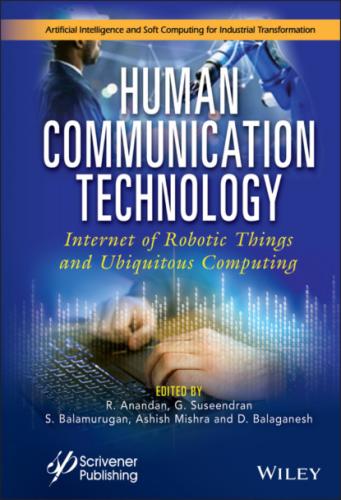21 Index
Guide
1 Cover
5 Preface
7 Index
List of Illustrations
1 Chapter 1Figure 1.1 Description of the IoRT innovations.Figure 1.2 Conceptual model of IoRT Architecture.Figure 1.3 Protocol stacks of IoT.Figure 1.4 Platform of IoRT.Figure 1.5 Service oriented test platform.Figure 1.6 Illustrates the connection establishment.Figure 1.7 Data analysis.
2 Chapter 2Figure 2.1 Foremost branches of IoRT.Figure 2.2 Process flow of electromyography signal acquisition.Figure 2.3 Neurosky electroencephalograph headset available in Market.Figure 2.4 Electrode positioning of brain for extracting the electroencephalogra...Figure 2.5 Categories of feature extraction techniques.Figure 2.6 The flow of data speed, client connection and data transfer of mobile...Figure 2.7 The logical flow of brain–computer interface system software.Figure 2.8 GUI of brain–computer interface based software.
3 Chapter 3Figure 3.1 Sequence of states in IoRT systems.Figure 3.2 Model checking approach.Figure 3.3 PRISM model checking overview.Figure 3.4 UPPAAL basic structure.Figure 3.5 SPIN overview.Figure 3.6 Automated theorem proving and logic.Figure 3.7 Higher level view of alt-ergo.Figure 3.8 CodeSonar overview.Figure 3.9 IoRT Validation key concerns.Figure 3.10 Approach to IoRT testing framework.Figure 3.11 Automated test frameworks types.Figure 3.12 Modular driven framework.Figure 3.13 Library architecture.Figure 3.14 Data driven framework.Figure 3.15 Keyboard driven framework.Figure 3.16 Hybrid automation framework.Figure 3.17 BDD automation framework.Figure 3.18 IoRT testing.Figure 3.19 Priority of testing mode.Figure 3.20 Automated validation process.Figure 3.21 Key strategies for IoRT security.
4 Chapter 4Figure 4.1 Working principle of Li-Fi.Figure 4.2 M2M communication system.Figure 4.3 Basic building blocks of Li-Fi & its applications.Figure 4.4 Arduino Uno development board.Figure 4.5 Li-Fi transmitter circuit.Figure 4.6 Li-Fi receiver circuit.Figure 4.7 Li-Fi navigation system for blind people.Figure 4.8 Vehicle to vehicle communication using Li-Fi.Figure 4.9 Li-Fi at ICU room.
5 Chapter 5Figure 5.1 Cross-over representation.Figure 5.2 Representation of mutation process.Figure 5.3 Robot interaction for disease prediction—belief network.Figure 5.4 Data collection.Figure 5.5 HRV measures prediction.Figure 5.6 Attribute selection.Figure 5.7 Graphical representation of Bayesian belief network model.Figure 5.8 Final model tree for the combination of attributes.Figure 5.9 Final output of in terms of performance measures with classified resu...
6 Chapter 6Figure 6.1 Human-centric computing.Figure 6.2 Proposed methodology.Figure 6.3 Data partition in the network.Figure 6.4 The output is predicted after attaching weights to the subnetworks.Figure 6.5 Multimodal data performance.Figure 6.6 Performance metrics.Figure 6.7 PPV and NPV performance.Figure 6.8 Proposed methodology overall performance.
7 Chapter 8Figure 8.1 Communication architecture of IoRT.Figure 8.2 Robot as a node in IoT vs robot as a client of IoT.
8 Chapter 9Figure 9.1 Proposed system architecture.Figure 9.2 Flow diagram of the proposed system.Figure 9.3 MQ2 gas sensor module.Figure 9.4 MQ3 gas sensor module.Figure 9.5 MQ6 gas sensor.Figure 9.6 MQ135 gas sensor.Figure 9.7 NI-WSN-3202.Figure 9.8 Block diagram of NI WSN 3202.Figure 9.9 Analog input circuitry.Figure 9.10 Simplified circuit diagram of one DIO channel.Figure 9.11 NI WSN-3202 pin out.Figure 9.12 NI WSN gateway (NI9795).Figure 9.13 Mesh configuration example.Figure 9.14 Compact Rio (NI 9039).Figure 9.15 Architecture of compact Rio (NI9082).Figure 9.16 Sensor array in glass chamber for data set creation.Figure 9.17 Front panel of data acquisition system.Figure 9.18 Dataset of ethanol gas.Figure 9.19 Dataset of petroleum gas.Figure 9.20 Dataset of ammonia gas.Figure 9.21 Sensors voltage level at 1,500 ppm.Figure 9.22 Sensors voltage level at 1,600 ppm.Figure 9.23
